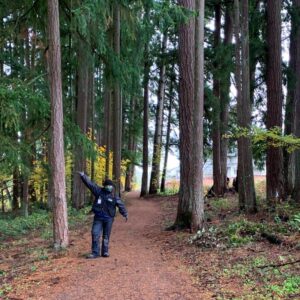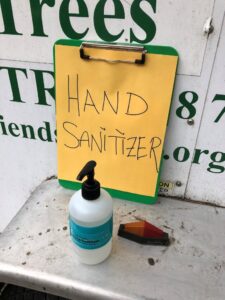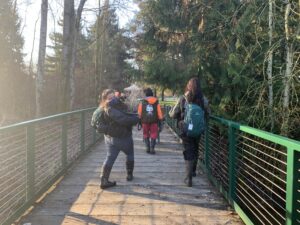Category: planting trees
Trees at the Bybee Lakes Hope Center

Trees are on the path to recovery and reentry at the Bybee Lakes Hope Center
For 16 years a giant empty building sat on a large, barren site in North Portland. Today, what was intended to be the Wapato Jail is now a place of recovery and hope, surrounded by new trees and a new Victory garden.
The Bybee Lakes Hope Center, run by Helping Hands Reentry Outreach Centers, serves people who are experiencing homelessness. Friends of Trees played a part in helping establish green infrastructure at the site and now BLHC residents, staff and volunteers have access to what is essentially a mini-arboretum, where a wide variety of trees will do what trees do best: clean the air, provide oxygen, shade, and habitat for bees and birds, while also helping to ease stress and contributing to other positive health outcomes for the folks who live there.
Reading about how BLHC redefined space inspired Friends of Trees Deputy Director Whitney Dorer to take a deeper look. Whitney shares, “I loved that a place intended to incarcerate became a place of healing and renewal, but I was struck by the lack of vegetation, there wasn’t anything green surrounding the building. I thought about someone staying in that building and wanting to go outside, and that there was no shade, no outdoor respite. I thought Friends of Trees could play a role.” So Whitney reached out to HHROC with a tree planting proposal.
Whitney met with Raven Russell, Director of Data & Major Projects for HHROC and the project grew. VetREST Oregon, which serves veterans, joined as a partner to create a Victory Garden where residents can grow their own food. Partners and residents were joined by landscape designer Tracy Ceravolo who donated her time to help design the site and choose trees. More than 20 different species are planted at the site, including red alder, American beech, dawn redwood, incense cedar, doug fir, fig and other fruit trees, magnolia, scarlet oak, Oregon white oak, giant sequoia … and more!
Friends of Trees Senior Neighborhood Trees Specialist Andrew Land helped with the tree side of things, “It was like designing an arboretum! It’s a huge variety of trees, chosen for drought tolerance, disease and pest resistance, and also chosen with an eye toward having a variety of leaves, flowers and forms.”
HHROC Development Director Mike Davis applauds the partnership,
“The partnership between our organizations has been great as we’ve worked to build out our therapeutic Victory Garden. Having Whitney and Drew guiding us on the types of trees as well as their care has been invaluable and will ensure that our trees grow and thrive. Without Friends of Trees and their volunteer army, we couldn’t have planted 150 trees in 1 day.”
Tree care shouldn’t be a problem at this site because residents and community volunteers are available. A recent visit to check on the trees after an unseasonable warm spell demonstrated that the BLHC community has done an excellent job—the trees are well-watered and thriving!
Bybee Lakes Hope Center in and of itself is an amazing place, providing much-needed services to people in our community who are experiencing houselessness. And thanks to a special partnership, the blank slate of the site is getting green and actively contributing to people’s restoration and healing.
We plant yard trees, too!

Get to Know our private property plantings
Street trees planted by Friends of Trees are pretty recognizable—some may say iconic, even. Street trees are the trees planted near the street, identifiable by the Friends of Trees tree tag with information about the species and tree care. But street trees are only part of the picture.
Yes, we’re also restoring natural areas through planting native trees and shrubs, but there’s another aspect to our tree planting that also provides oxygen, fights climate change, and brings people together: it’s planting trees on private property.
Friends of Trees increasingly plants more trees on private property, which is any planting site that is not owned by a municipality or is not a public right-away (such as the planting strip). These locations range in size and flavor, including a large site like the Bybee Lakes Hope Center described in the story above, a private backyard (the most common), the grounds of an apartment complex, at a business … anywhere a tree can fit and live (remember, right tree, right place!).
In a typical season we plant 1,000 yard or other private property trees, and it’s a part of our planting program we’re actively growing. In many ways, planting trees on private property allows for more options and flexibility, especially in yards where there is more choice in tree type because there is often room for larger trees. Neighborhood Trees Program Manger Erica Timm explains,
“I always wanted an Oregon white oak at my home, but I couldn’t plant one as a street tree because they are just too big for my planting strip, so I planted one in my backyard. And because there’s more room in my backyard I was able to plant more native trees and now, combined with my neighbor’s trees, we have a little grove of native trees right outside our back doors. All these trees provide habitat, they capture stormwater, trap pollutants … it’s all the benefits of street trees multiplied many times over since there is space for so many more trees.”
Friends of Trees has been very successful in growing our urban canopy through planting street trees, and offering yard trees is a natural continuation of greening our neighborhoods. We’ll plant street trees as much as we can, but the public right-of-way, such as the planting strip, is a busy space, with sidewalks, utilities (both above-ground and below), etc., and there is more competition for space, so more yard trees is definitely part of our future.
Just like planting street trees, when a tree recipient is interested in a yard or other private property tree we spend a lot of time helping select the right tree for the right place, hole digging, utility locates (know before you dig), and we provide tree care information such as watering reminders. So before you head out to your local home improvement store for your backyard tree, check with Friends of Trees, because in addition to planting a tree, you’ll get expert help and advice, and you’ll grow some community, too.
Photo: A happy yard tree recipient in NE Portland, March 2021.
The Power of Partnerships
CONNECTING YOUTH TO NATURE, JOB TRAINING FOR THE ENVIRONMENT: JUST A COUPLE OF ELEMENTS OF SOME AMAZING PARTNERSHIPS
What started as a group of neighbors planting trees together 32 years ago has grown into a true community-based organization engaged in a wide variety of partnerships. Friends of Trees’ partnerships contribute to environmental education for K-12 students; adult job training programs; paid internships connecting underserved communities to the urban forestry field; greening low canopy neighborhoods; and so much more.
“Thank you for letting us come and plant with you, it was a GREAT experience. I learned that planting trees keeps us healthy and alive. It was a great opportunity to learn and also to be outside.” Kara, 4th grade, Friends of Trees-Charles F. Tigard Elementary School partnership
“American children now spend an average of only four to seven minutes per day playing outdoors, compared with over seven hours per day in front of a screen.” 1 That alone justifies our work with more than 2,000 young people in a typical season.
Friends of Trees’ educational programming actively and meaningfully connects youth of all ages with nature. We’re in the classroom with information about the benefits of trees, and we’re outside, actively planting and caring for trees with young people. Our work with high school students includes leadership skill building and job training through paid internships. Some stories about our youth education partnerships are here.
“Partnering with Friends of Trees has helped teach Wisdom interns management skills; we learn how to manage a business, how to engage with business people, it prepares everybody for employment.” Alvey Seeyouma, Wisdom Workforce Development Program Coordinator and Crew Leader Supervisor
A growing partnership endeavor, our Adult Urban Forestry Program, includes as past and current partners APANO, POIC, Verde, Wisdom of the Elders, Blueprint Foundation, and the Black Parent Initiative. The program connects historically underserved community members with job training and internship opportunities in the urban forestry field, read more here.
Greening low-canopy neighborhoods is an ongoing priority for Friends of Trees, and our work with APANO and other partners on the Jade Greening Project helps address this in an equitable way. Low-canopy neighborhoods are often low-income and home to historically underserved communities. These neighborhoods, such as NE Portland’s Jade District, experience significant environmental health disparities, stemming from exposure to air toxins and lack of walk-ability/accessibility. The Jade Greening Project engaged Jade District residents in dialogue about community needs to ensure the greening and revitalization–and not the gentrification- of the Jade District.
This is not an exhaustive compilation of partners, and doesn’t even touch on the more than 1,000 groups that have planted with us over the years! We’ve hosted all the scouts, reunions, birthday celebrations, employer groups, college students, high school students, elementary school students … it’s truly inspiring to see how many groups of you celebrate milestones or learn or bond or just choose to get together through planting trees together. We can’t wait to welcome you all back again!
1 National Recreation and Park Association
photo: Rosemary Anderson HS POIC students at a recent planting event.
Thank you! And happy new year.
To all of our supporters,
THANK YOU.
Your support in 2020 meant that, despite unimaginable obstacles, we were still able to plant trees + grow community.
What a year.
So many people supported us in so many ways, it has often brought me to tears. Your commitment is real and I thank you for that.
Your support plants trees in neighborhoods and natural areas while bringing people together and building resilience in our communities.
We can’t do this without you!
Here’s to a tree-filled 2021,

Whitney Dorer, Interim Executive Director
PS: Plant trees with us! When we are planting we are doing so with a number of health and safety features in place to ensure our events are as safe as possible. Check out our events calendar for the latest information about our community tree planting events – and how to get involved!
Reflecting on 2020: the year of the pivot

More like multiple pivots, really. Just like trees though, flexibility to bend and not break in the storm is how we modeled ourselves this year. Despite canceling, postponing and downsizing many volunteer planting events due to the pandemic, in 2020 we still planted 38,000 trees and native shrubs with the support of more than 5,000 volunteers. COVID-19, the racial justice uprisings, and signs of a changing climate caused us to look inward, and recommit to why we do what we do. These are our biggest takeaways from 2020, with some feedback from supporters sprinkled in:
It’s all about community and accomplishing something hard, together. To our volunteers and supporters: In the darkest times of this year, your patience, conviction, and generosity have buoyed us. Every time you reach out, get a tree, volunteer, or donate, you cast a vote for the future you want. This has been a year of unpredictability, but we know one thing with steadfast certainty: with people like you, we can move mountains.
What we’ve heard:
- Keep holding events! Everyone in my pruning group was so thankful to be outside and get to interact with other people from a distance. We also had numerous residents come out and let us know how thankful they are that FOT provides this service.
- I learned so much! About the plants, how to plant them, best species for flooded areas. It was really fun!
- Got a great deal on five new trees for my back yard. Met some great people and laughed together. Made a new friend too!
- Thank you for supporting our community and the environment one tree at a time. I’m so thankful for the work you do on a daily basis.
Moving toward being an anti-racist and inclusive organization and society takes continual work. The pandemic has illustrated racial disparities in this country. There are also divisions along race lines regarding who has access to nature and the outdoors, who benefits from jobs in the fields of urban forestry, and who receives the benefits of urban trees. We are tackling each of these challenges with steadfast resolve. Simultaneously, we’re seeking to rid ourselves and our programming of white supremacy.
Supporters’ feedback:
- I found the section on Environmental Justice and information on Portland tree canopy distribution to be particularly interesting. Lessons I learned about interrupting problematic language is definitely transferable to my day-to-day life.
- Thank you for the work you do and the voices you lift!
- Although I have previously read about privilege it was useful to consider it in relation to tree planting.
- You taught me my subconscious bias around using pronouns and I love you for it.

Going outside and engaging in community service are important for mental health. Studies show that both outdoor exposure and volunteering lowers stress, anxiety, and depression. We miss our big planting events. We’ll never take for granted ever again the beauty of being outside with a big group of people digging in the soil. When safer times are here, we want to make the next planting season our biggest yet!
- Keep up the hard work and dedication to this environmental necessity. Thank you for finding a way to keep the needle moving forward.
- The group I was with had great leaders, and an amazing group of people- we faced several obstacles throughout the day, and we tackled them all head-on, as a team. There was no conflict, arguments, nothing negative – it was entirely teamwork, lots of laughs and we all felt like we were productive! Plus I got a good workout!
- You are an awesome organization and I am happy to be a part of your family.

What else did we take away from 2020? More than one out of three of our staff say their easy-button pandemic food is frozen pizza. At 22% of our staff team, the most popular food for daily eating is chocolate. And we think we finally learned how to properly wash our hands.
In our volunteer surveys, we commonly ask folks, “Is there anything in particular that made your experience good or bad? One recent response: “It was over too quickly.” While we can’t say the same for 2020, we certainly had some fun times, and tried to make the best of a challenging situation.
Here’s to a tree-filled 2021!
This is a story from the December 2020 issue of Treemail, our monthly e-news! Read the entire edition here, and catch up on past issues here.

